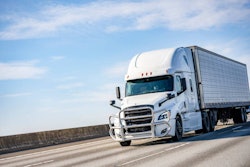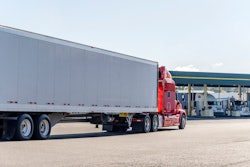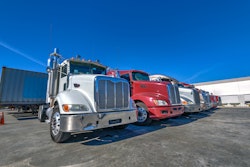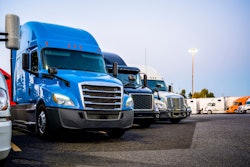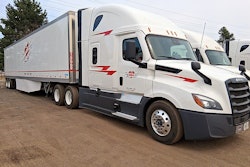Here’s what you need to know:
- Some carriers are cutting back capital expenditures in response to a sluggish freight market.
- Executives are prioritizing equipment replacement over expansion, deferring purchases, and adjusting sourcing strategies.
- With excess capacity and economic unpredictability, firms like TFI are pulling back on M&A.
As ongoing policy changes create disruptions, carriers have pointed to uncertain economic environment in the first quarter of the year, and executives are revising their strategies to mitigate potential cost impacts.
With Old Dominion Freight Line (CCJ Top 250, No. 9) reporting its total revenue (5.8%) and net income (12.9%) down year-over-year, President and CEO Marty Freeman cited financial performance to ongoing softness in the economy.
“We’ve not seen anything change from a big picture standpoint,” said ODFL’s Chief Financial Officer Adam Satterfield, adding that the company is planning for when a rebound does take place.
“We’ve got to continue to work toward the other side," he said.
Freeman noted that ODFL has seen an acceleration in February and March, which he said performed according to seasonal expectations, but he hopes tariff uncertainty will reach a resolution and prompt a boost in freight market activity.
As a result, ODFL is reducing its capital expenditure to be around $450 million in 2025, down 21.7% compared to prior expectations. Its planned expenditures now include:
- $210 million for real estate and service center expansion projects, down from $300 million
- $190 million for tractors and trailers
- $50 million for information technology and other assets
J.B. Hunt (No.3) is also reducing its capex from $700 million to $900 million to $500 million to $700 million on equipment and real estate for the year, reflecting a tactical shift towards reducing costs and improving profits amid the environment.
“We are not pleased with our returns, and efforts across the organization continue to reduce and eliminate costs, refine our capital plans and drive further productivity across our businesses,” J.B. Hunt CEO Shelly Simpson said during a call with investors, adding that lowering costs for shippers and its own operations in such a volatile market has been a challenge, and expenses haven’t declined in step with falling revenues.
J.B. Hunt CFO John Kuhlow added that the bulk of this year’s capital spending will focus on replacing aging equipment with secondary investments directed towards expanding its dedicated capacity segment. Kuhlow also said the company has already cut $200 million in personnel costs over the past two years, though rising costs in areas such as insurance have offset some of the savings.
[RELATED: Why insurance premiums keep rising, and what fleets can do about it]
Additional cuts may be on the table, Simpson noted during the call, citing unpredictable economic environment, which she described as “changing by day, or the tweet, or the moment.”
In other cases, Derek Leathers, CEO of Werner Enterprises (No. 14), mentioned that its customers have been telling the company that their inventory levels are in good shape, though it reported results as below expectation due to insurance costs and claims, weather and customer demand.
Leathers said they are exploring various strategies to manage the cost pressure caused by tariffs. These include postponing planned tractor purchases and sales – a viable option given the company’s young fleet, which has an average age of 2.2 years – and shifting orders to OEMs that are less affected by the tariffs.
The company is bracing for higher equipment costs as it continues its fleet replacement cycle, Leathers said.
“We will continue to invest in trucks, trailers, technology and talent, while maintaining optionality when it comes to evaluating the impact from tariffs on our equipment costs,” he added.
[RELATED: Strong demand drives up used truck prices and volumes]
If tariffs remain in place, the company expects equipment and parts costs to increase by low single-digit percentages. However, rising demand and strong resale values for used equipment are likely to cushion the impact.
“We are seeing increased values on used equipment as pricing on new equipment is fluid and recently being influenced by tariffs,” Leathers added.
Meanwhile, TFI International (No. 5) is adjusting its merger and acquisitions approach.
Though its revenue increased by 61% due to its acquisition of Daseke, CEO Alain Bédard said in an earnings call that economic uncertainty and tariffs imposed on steel and aluminum imports by the Trump administration, along with existing truckload weakness from previous quarters, impacted its specialized truckload segment.
When TFI acquired Daseke in December 2023 for $1.1 billion, it brought on 4,900 tractors and 11,000 flatbed and specialized trailers.
“We’re not using our trucks to the full extent,” Bédard said, adding that there’s pressure on its flatbed metrics because of underutilization.
Due to excess capacity in its truckload business, TFI is calling back on its capital spending, reducing its 2025 capital expenditure forecast from $300 million to $200 million.
Tariff uncertainty was a factor, the CEO said.
“We had to walk away from a transaction that was a great transaction for both parties, the seller and us, and we had to walk away because of all this environment,” Bédard said. “Because of all this uncertainty, we said, no, forget about it.”
“M&A in 2025 is going to be minimal,” Bédard said, adding that it is focused on buying back its own stock and improving its U.S. LTL business.




